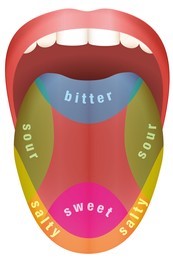
The tongue is covered with about 9000 taste buds that help us to detect flavors, explains Professor Damien Walmsley, scientific adviser to the British Dental Association. The taste buds themselves are a collection of cells on the surface of the tongue, each housing about 50 to 100 taste cells. The buds renew themselves every 10 days to 2 weeks. However, anything that causes inflammation, such as infection or smoking, can damage the taste buds and affect their renewal, deadening their sensitivity.
You can’t actually see your taste buds, they are those little bumps on your tongue are called papillae, and while they do contain taste buds, they also help with chewing, speaking, and cleansing your mouth.
Taste buds are all over your mouth—not just your tongue—and there are a lot of them. “Each taste bud is a collection of about 50 to 100 cells that are tasked with testing your food before you swallow it.
Once the food dissolves in your saliva, it activates receptors at the tips of the cells, which can distinguish between sweet, salty, sour, bitter, and umami or savory. The receptors then send a signal to your brain to relay the exact flavor you’re experiencing.
Can your taste buds change?
Essentially, every time you burn or chomp down on your tongue, you kill off more taste buds. Luckily, they grow back very quickly which is why you only go a few days without the sweet taste of coffee after scorching your tongue
“Taste dysfunction can…result from an alteration of the renewal capacities of taste buds and is often associated with psychological distress and malnutrition,” said the study’s lead author Dany Gaillard, PhD, an instructor in cell and developmental biology at CU Anschutz.
Dr. Gaillard said that understanding how taste cells renew throughout adult life and how new cells replace old cells as they die, is essential in finding potential therapies to improve taste sensitivity in those patients impacted.
Using mouse models, the researchers discovered that a protein in the Wnt pathway, called ß-catenin, controls the renewal of taste cells by regulating separate stages of taste cell turnover. The protein is crucial in developing taste buds in embryos and is a regulator of the renewal of epithelial tissue in adults including skin, hair follicles, intestine and the inside of the mouth.
These nutrition deficiencies can also contribute to a reduced ability to taste food:
* Folic acid (or folate) is abundant in legumes and vegetables and green leafy “foliage” — helps in the formation of new cells within the body. Interestingly, a deficiency of this vitamin can show up as a smooth, red tongue and resulting loss of taste sensation.
* Vitamin B-12 is a vitamin found almost exclusively in foods of animal origin (meat, fish, chicken, eggs, milk) — is closely related to folic acid. A deficiency of vitamin B-12 may affect the nerves that carry taste sensations to the brain.
Note: Microwave cooking destroys vitamin B-12. Best to cook meat and other B-12 containing foods by another method.
* Thiamine or B1 is a B-vitamin found primarily in whole grain or enriched grain products — occupies a special site on nerve cells. A deficiency of thiamine can therefore interfere with normal taste sensations.
* Zinc is a trace mineral found in high amounts in oysters, beef and crab. It supports several processes in the body, including the perception of taste. A deficiency of zinc can cause changes in taste and appetite.
In conclusion, a well balanced diet with lots of vegetables, good lean protein and complex carbohydrates is your best ally to keep your taste buds healthy.
Christine Gozlan
B.H.Sc. Naturopathy
Dip. Herbal Medicine
Dip.Nutrition
